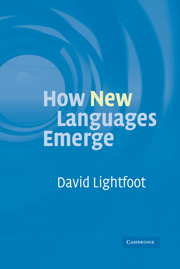Book contents
- Frontmatter
- Contents
- Preface
- 1 Internal languages and the outside world
- 2 Traditional language change
- 3 Some properties of language organs
- 4 Languages emerging in children
- 5 New E-language cuing new I-languages
- 6 The use and variation of grammars
- 7 The eruption of new grammars
- 8 A new historical linguistics
- References
- Index
3 - Some properties of language organs
Published online by Cambridge University Press: 02 February 2010
- Frontmatter
- Contents
- Preface
- 1 Internal languages and the outside world
- 2 Traditional language change
- 3 Some properties of language organs
- 4 Languages emerging in children
- 5 New E-language cuing new I-languages
- 6 The use and variation of grammars
- 7 The eruption of new grammars
- 8 A new historical linguistics
- References
- Index
Summary
Recursive and compositional
English, Dutch, etc., are external languages and such “languages” have no biological reality and cannot even be defined in any precise way, as we saw in the last chapter. Certainly children do not acquire one of those external objects, as if selecting from a supermarket aisle. In this chapter I shall begin to examine a different approach, where we view languages as private, internal, individual entities. A person has a linguistic capacity, acquired under the conditions of childhood, and represented in his/her brain. No two people speak absolutely alike and, personally, I speak David Lightfoot, slightly different from my brothers' speech, and our mother can tell us apart on the telephone. We shall investigate some of the properties that a person's individual language must have, what we are calling her I-language, and the way that it is acquired in childhood.
First, as we noted in chapter 1, a person's language capacity ranges over an infinitude of data. One can appreciate this on an intuitive level. One expresses and encounters new sentences all the time. Take any random sentence from the last chapter and it is likely that you have not said it or heard it in just that form, but there is no difficulty in understanding what it means, or so I hope. Similarly the next complete sentence that you utter is likely to be novel.
- Type
- Chapter
- Information
- How New Languages Emerge , pp. 40 - 65Publisher: Cambridge University PressPrint publication year: 2006



